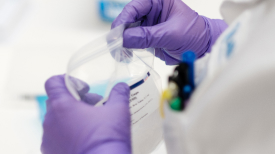- Cancer Care Team
Cancer Care Team
To deliver optimal patient outcomesProducts and Services
Cancer Type
Supplies & Tools
Scientific Focus
- Biopharma Partners
- Patients
- Education & Events
- Login
- Contact Us
Test Details
Use
The assay is designed to detect aneuploidy for chromosomes 3, 7, 17, and loss of the 9p21 locus via fluorescence in situ hybridization (FISH) in urine specimens from subjects with transitional cell carcinoma of the bladder. This assay does not detect other chromosomal or genetic alterations. Results are intended for use as a noninvasive method of monitoring for tumor recurrence in conjunction with cystoscopy in patients previously diagnosed with bladder cancer. The clinical interpretation of test results should be evaluated within the context of the patient's medical history and other diagnostic laboratory test results.
Special Instructions
Specimens should be received at the laboratory within 72 hours postcollection for optimal testing. Specimens older than 72 hours will not be rejected; however, results not guaranteed. In these instances, clients should consider recollection if possible.
Limitations
Positive FISH results in the absence of other signs or symptoms of bladder cancer recurrence may be evidence of other urinary tract-related cancers (eg, ureter, urethra, renal, and/or prostate in males), and further patient follow-up may be helpful. Negative FISH results in the presence of other signs and symptoms of bladder cancer recurrence may need to be regarded as suspicious false-negative results; repeat testing may be indicated. Although the assay was designed to detect chromosome changes associated with most bladder cancers, there are some bladder cancers whose genetic changes are not targeted by this test.
Methodology
Fluorescence in situ hybridization (including diagnostic interpretation by MD pathologist)
Specimen Requirements
Information on collection, storage, and volume
Specimen
Urine
Volume
50 mL urine mixed with preservative in TCC Monitoring kit
Minimum Volume
33 mL urine mixed with preservative in TCC Monitoring kit
Container
TCC Monitoring kit (PeopleSoft item N° 44921). Other containers that are accepted, but not recommended: PreservCyt® vial, Cytology Special Studies Kit (PeopleSoft item N° 3203), or sterile urine container with Carbowax® fixative (two parts urine; one part fixative).
Storage Instructions
Specimen should be refrigerated at 2°C to 8°C and shipped on cool packs. Do not freeze.
Causes for Rejection
Incorrect fixative; significant contamination with blood obscuring bacterial overgrowth; inadequate specimen cellularity
Collection
Step 1: Use the large, open cup in the kit to collect the urine specimen. First void of the day is preferred. Ensure that the urine specimen reaches the minimum fill line of 33 mL.
Step 2: Slowly pour urine into the smaller container to the maximum fill line of 90 mL.
Step 3: Tighten the lid until you hear a click in order to prevent leakage.
Related Tests
Find more tests related to this one.





